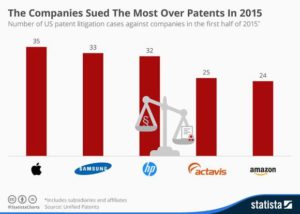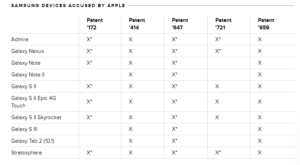Patent Wars
This week I am bringing to our class of tech enthusiasts and curious minds a topic of patent war and its interesting cases. The patent is not so new term in the tech industry. Patent wars started a long time ago f.e. it was famous Abraham Graham Bell, who was accused of stealing and plagiarized the successful design for a telephone from his rival Elisha Gray. Thanks to Bell’s lawyers and U.S Congress, Bell ended up as a winner of the telephone controversy and his patent was issued on March 7. History is often written by winners and thus we remember him as the official inventor.
Nowadays, a technology patent is understood as an exclusive monopoly right granted by a national or regional patent office to an inventor who has created something new, useful, and non-obvious. Obtaining a patent is an important for any technology company developing a unique new product to prevent others from using, selling, manufacturing or otherwise copying the innovation without permission for a limited period, usually 20 years.
In 2015, the United States tracked the highest number of patent disputes in its history, according to Statista.

Apple’s brand starts to become a commodity when talking about a patent war. From 2009, Apple was involved in numbers of lawsuits with Nokia, Microsoft, Samsung, HTC, Motorola, Velocity Micro and few others. of the most Inn 2011, Apple and Samsung started to carry a patent legal war which cost more than a billion dollars to each company carrying legal processes on 4 continents. Apple-Samsung was one of the most significant patent war cases where both companies were fighting over a patent related to mobile technology and design. Allegedly, Samsung’s overall appearance of the phone, its screen and icons looked the same as the iPhone’s. Patented features such as rubberbanding, in which a screen image bounces slightly when a user tries to scroll past the bottom, were almost identical. Also, an automatic correction of words was claimed as stolen. Same with a pinch to zoom which allows users to manipulate image size by pinching the thumb and forefinger together on the screen. Well, no surprise Steve Job’s initiated Apple to sue Samsung for its patent violation and kicked off a series of legal jurisdictions across the globe. Initial court decision stated that Samsung owes Apple more than a billion of dollars followed by various updates. Samsung argument brought an idea that Apple’s patents are invalid and obvious, and should not be a legitimate means by which the company could collect damages. In meanwhile, Samsung accused Apple involving their features such as camera, folder organization functionality, video transmission functionality, and FaceTime technology into iPhone.


Hence, the court’s agreement was called into question of the validity of Apple’s patent and a case was brought in front of the Supreme Court looking to settle things once and for all.
The process ended recently with no clear-cut win and both companies were found guilty. Apple received less than 10% of the damages it initially requested. However, there was much more money involved than we could think of. Samsung had to pay for infringing 3 Apple’s patents and at the same time, Apple was ordered to pay Samsung for infringing 1 Samsung patent.
That was not the only long-lasting patent war in which Apple was involved around this time. Another one started in 2009 with Nokia and was few times postponed and closed. The last opening was in December 2016, Apple filed a lawsuit against Nokia, accusing the company of stealing numbers of patents and calling the company a patent troll. Nokia struck back and filed legal challenges to accuse Apple of infringing 32 Nokia’s patents. According to Nokia, every version of the iPhone, from the iPhone 7 all the way back to the 3GS, infringed Nokia patents.
In 2017 Apples-Nokia fight over intellectual property ended up their legal hatchet just after few months. On May 23, in Cupertino, California and Espoo, Finland – Nokia, and Apple settled the agreement related to their intellectual property dispute and agreed to a multi-year patent license.
Maybe, it was an experience that taught Apple how long and costly a battle with giant competitors and quirky jurisdiction can be. Jeff Williams, Apple’s chief operating officer said: “We are pleased with this resolution of our dispute and we look forward to expanding our business relationship with Nokia.” The same was claimed on Nokia’s side. “This is a meaningful agreement between Nokia and Apple,” said Maria Varsellona, Chief Legal Officer at Nokia, responsible for Nokia’s patent licensing business. “It moves our relationship with Apple from being adversaries in court to business partners working for the benefit of our customers.” Under the agreement, both companies have agreed on providing each other services and products what leads to a potential further collaboration.
In many cases, patent lawsuits are filed by companies looking to get paid. This becomes a popular practice called patent trolling which is an increasing problem for the technology industry. Patent trolls can cost defendant firms $29 billion per year on average in direct out-of-pocket cost. Hence, money wasted in legal lawsuits and fines are big numbers what has accordingly a real impact on the economy. Unfortunately, money spent fighting patent trolls is money not spent on innovation, employees, and on companies development.
References
1 https://www.scientificamerican.com/podcast/episode/5f1a8f35-c6a1-6742-6dcb11d92dae6d09/
3 http://fortune.com/2016/02/26/apple-samsung-patent-appeal/
4 https://www.ft.com/content/04959354-c7b0-11e6-9043-7e34c07b46ef
6 https://www.fool.com/investing/general/2015/08/12/the-companies-sued-the-most-over-patents-in-2015.aspx
2 comments on “Patent Wars”
Comments are closed.


Very interesting blog topic — Thank you, Michaela!
Patents are important if the intellectual property is taken and not used “in good faith” but there is another school of thought that it’s a risk worth taking. The rationale is that opening them up will help accelerate technological progress, et large. One cool example here: https://www.tesla.com/blog/all-our-patent-are-belong-you
But as with everything, there are people that disagree: http://stellarix.com/ip-news/where-is-tesla-headed-to-with-its-open-source-movement/
In addition to some of the hardware examples you mentioned, another busy area for patent law and intellectual property is in the mobile application area. The app market is incredibly saturated with similar products, and as a result many developers seek to patent their ideas and protect them from being used by other, typically larger companies. The most common method is to file a provisional patent application, which establishes a date of filing and lasts for one year. This gives developers six to nine months to gauge the success of their product at a much lower cost than the typical $10,000 to $15,000 associated with a full patent application. Because of the similarities of many apps and the generally small size of most app developers, this market is ripe for the patent trolls you mentioned to purchase apps and attempt to patent them in order to go after similar competitors for patent infringement/ damages. For anyone interested in entering this market, the decision to patent or not should be considered very carefully.